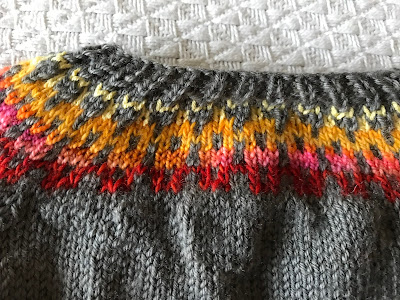J’essaie de ne faire des pâtes qu’aux deux semaines, de peur d’en manger trop (ou trop souvent!). C’est sûr que je tombe parfois sur une recette qui ne fonctionne pas à mon goût, comme ce
bolognese au chou-fleur de Bon Appétit. Ça avait pourtant bien commencé, avec des champignons hachés menu qui me rappelaient
mes pâtes du commerce préférées, mais l’ajout du chou-fleur a tout gâché, goût et texture (parce qu’il ne s’est pas attendri)… Dommage! J’ai ensuite essayé une recette de lasagne tirée du numéro de novembre 2016 du magazine
Tellement Bon! L’image portait la mention « Fait en 10 minutes! » et… c’était *complètement* faux! Et j’avais pris des raccourcis, en plus! Mais j’ai beaucoup aimé le résultat, et les enfants ont vraiment adoré – même si c’était vert et pas photogénique! Le Petite Prince m’a demandé d’en refaire à quelques reprises déjà. Il y a du brocoli ici qui est passé complètement inaperçu, soit dit en passant. Par contre, j’ai mis moins de petits pois qu’il en fallait, et je pense que je les laisserai tomber la prochaine fois.
La recette d’origine demandait du fromage mascarpone, mais je n’en ai pas vu sans lactose; j’ai remplacé par du fromage à la crème sans lactose, mais on pourrait envisager aussi du fromage ricotta maison (sans lactose également, bien sûr). Au lieu de faire des boulettes avec de la chair à saucisse pour ensuite les faire cuire, j’ai acheté des saucisses émiettées déjà cuites (comme
celles-ci) et c’est ce que je recommande, mais je mets les instructions d’origine ci-dessous au cas où vous n’en trouviez pas. Et bien sûr, j’achète des pâtes à lasagne qui sont prêtes à aller au four au lieu de devoir les faire cuire moi-même en plus de tout le reste. La recette demandait un plat 10"x14"; je n’en ai pas, alors j’ai pris mon 9"x13", et même à ça, le plat était trop grand. Je prendrai un plat 8"x11" la prochaine fois. J’imagine que ça dépend de la largeur des pâtes, mais je pensais que c’était assez standardisé, ça, non?
Vous pouvez servir le tout avec une salade verte.
4 c. à soupe d’huile d’olive, en tout
6 saucisses italiennes douces, chair retirée des boyaux, puis roulée en petits boulettes (voir plus haut)
1 petit brocoli (400 g), coupé en petits fleurons
1 tasse (250 g) de tomates cerises, coupées en deux
sel et poivre, au goût
1 1/3 tasse (200 g) de petits pois surgelés (voir note plus haut)
1 ¾ tasse de fromage à la crème sans lactose (voir note plus haut; j’en avais un peu moins)
1 tasse (150 g) de pesto maison ou du commerce
1 grosse botte de basilic, hachée
12 pâtes de lasagne, cuites et égouttées (j’ai pris des pâtes prêtes à aller au four)
¼ tasse de lait sans lactose
1 tasse (100 g) de fromage mozzarella sans lactose râpé
3 c. à soupe de parmesan râpé
2 c. à soupe de pignons (facultatif)
Dans une grande casserole, à feu moyen-vif, chauffer la moitié de l’huile et y faire revenir les boulettes de viande en les faisant rouler, de 5 à 10 minutes ou jusqu’à ce qu’elles soient dorées. (Mes saucisses émiettées étaient déjà cuites, alors j’ai sauté cette étape.)
Entretemps, porter une grande casserole d’eau salée à ébullition à feu vif et y cuire le brocoli 3 minutes ou jusqu’à ce qu’il soit très tendre. Bien égoutter.
Préchauffer le four à 400 °F. Dans un petit plat de cuisson, mettre les tomates et les arroser du reste de l’huile. Saler et poivrer généreusement les tomates, puis les faire rôtir au four 10 minutes, jusqu’à ce qu’elles ramollissent légèrement.
Dans la casserole, ajouter aux boulettes le brocoli cuit, les petits pois, la moitié du fromage à la crème, le pesto et le basilic. Laisser mijoter 2 minutes ou jusqu’à ce que la sauce épaississe. Saler et poivrer.
Dans un plat de cuisson de 9"x13" (ou 8"x11") huilé, étendre le tiers de la sauce. Couvrir du tiers des tomates, puis de 3 lasagnes. Répéter l’opération, en réservant quelques tomates pour en garnir la lasagne, et en terminant par un rang de pâtes. Dans un petit bol, mélanger le reste du fromage à la crème avec du lait pour en faire une sauce. La verser sur la lasagne, en l’étalant uniformément. Parsemer de mozzarella, de parmesan, de pignons et des tomates réservées. Cuire la lasagne jusqu’à ce qu’elle soit dorée et que la sauce bouillonne, de 35 à 40 minutes.















































